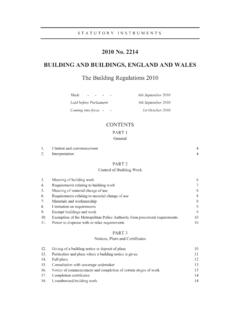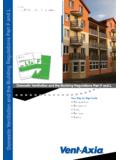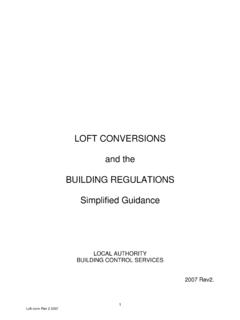Transcription of Part L1B and what you need to know to get your …
1 part L1B & What you need to know to get your building to pass . Mike Andrews DipNDEA, DipDEC, DipOCDEA, DipHI The building regulations part L1B what they are, how they affect your building design, and what you need to know . part L1B and what you need to know to get you building to pass Contents Introduction Who or what is an Approved Assessor? Who am I? What is part L1B? What Buildings are covered in L1B? Inclusions Exemptions Conservatories & Porches What is actually required to gain compliance the details Thermal Elements The Provision of Thermal Elements Continuity and Air Tightness Renovation of Thermal Elements 15 Year Payback Retained Thermal Elements Controlled Fittings Demonstrating Compliance Submissions and Competent Persons Standards of Materials & Workmanship Ways of Demonstrating Compliance Reference method Area Weighted U Value Calculations
2 Heat Loss Calculations Whole Dwelling Method Material Change of Use Change of Energy Status Controlled Services Domestic Heating Services Compliance Guide Commissioning of Fixed building Services Consequential Improvements to Energy Performance Providing Information What information is required to carry out a calculation? Appendix 1 If at first the idea is not absurd, then there is no hope for it - Albert Einstein Introduction I like the quote above because when I first thought about trying to write this series of books, I thought it was slightly bonkers to try and summarise the whole process, and also I didn t want to just repeat what was written in the manuals.
3 It also became clear to me that many people get confused by what they are being asked to provide in order to comply with the part L, and also that as an assessor, we have requirements for information that will help both the client and ourselves to complete the calculation in the most time and cost effective way and still achieve the best results for the building a lot of this is down to the quality of the information supplied. This book will hopefully make the whole process of what is required, the information needed to carry out the calculations, and make L1B a lot easier to understand.
4 Do any of these sound familiar to you? - If you are an architect and you are asked by building Control to provide an L1B calculation, do you know what they mean? - If you are a building Control officer do you know what is actually required when you ask for a calculation to demonstrate compliance with L1B - Do you know what buildings actually require an L1B calculation? - Do you know what energy assessors actually do, and what information they need to carry out the calculations? - What is an L1B calculation and why do I need one?
5 - What is different between an L1B calculation and a SAP calculation? If you answered No or Don t know to any of the questions above you are not alone, and the purpose of this book is to answer those questions and many more you may have too. In fact the aim of this book is simple, to explain the main requirements of part L1B, how this links in with SAP, how we demonstrate compliance for L1B, and what information the building designer will need to supply to an approved assessor in order to carry out the calculation. Finally, and perhaps most importantly for you if you are the building designer, it will cover what impacts the design the most in terms of gaining a pass .
6 Its not a step by step on how to pass the regulations , every building is different and to try to give examples of each would be impossible. On a final note, writing this type of document whilst interesting, could as easily be as dull as ditchwater, so baring that in mind I have tried to make it an easy read, and I make no apologies for my sense of humour! Who or what is an Approved Assessor? Assessors have to complete a training course using their chosen SAP modelling tool, pass an exam, submit a number of properties for assessment, and once passed can practice as an approved assessor.
7 They must also belong to an Approved Accreditation Scheme and follow each scheme Code of Conduct, have appropriate insurance, and carry out a prescribed number of hours of Continuing Personal Development each year. Once qualified to provide SAP calculations and Energy Performance Certificates it is possible to top up with further training that covers the requirements of part L1B, some of which requires the use of the SAP tool, whilst other aspects do not. Who am I? I have been producing calculations and reports for all aspects of part L for a number of years, and work with Architects and building Control bodies providing guidance and training in all aspects of part L, and also work with them to help clients gain compliance.
8 It s important to me that the result is the best that is achievable, and not just a pass to gain compliance minimums, if you are going to do the job you may as well do it to the best possible standard. I am qualified to produce L1B calculations because I am a qualified On Construction Energy Assessor & SAP Assessor. I have worked on hundreds of buildings of all types, from small two room extensions, houses and flats to very large office buildings and factories. I am a commercial building assessor able to produce SBEM calculations and compliance with L2A & L2B.
9 I am also a Public building Assessor able to produce Display Energy Certificates (DEC s), and a qualified Code for Sustainable Homes Assessor. This book is the forth of a four part series covering all four sections of part L compliance, namely part L1A new domestic buildings, part L1B, existing domestic buildings, part L2A new build non domestic buildings, and part L2B existing non domestic buildings. This book concerns part L1B only. What is part L1B? part L1B is one part of the four parts to part L of the building regulations Conservation of Fuel and Power in existing dwellings.
10 This book concerns the requirements of the October 2010 regulations , and will be updated as the regulations are changed, the next due at time of writing in 2013. The regulations and how to comply with them are contained in an Approved Document, ADL1B, there are other ways of demonstrating compliance with the regulations but in terms of the most straightforward, following the guidance in the AD is the simplest. The Regulation itself is straightforward, and in fact to comply with part L1B there are 3 sections referred to: Regulation 4A Thermal Elements if an element is replaced it should meet the minimum requirements, and if new it should also meet minimum requirements of thermal efficiency.





